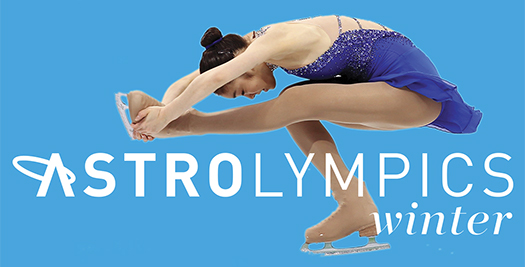NASA's 'AstrOlympics' Posters Show Physical Parallels of Space and Sports

A free series of posters made by NASA is highlighting the truly out-of-this-world physics of winter Olympic sports.
The NASA Chandra X-ray Observatoryis showcasing the physical parallels that Olympic athletes share with celestial objects. By checking out "AstrOlympics," space and sports fans can learn the commonalities between figure skaters and rotating pulsars, the similarities between ski jumpers and crashing galaxies, and what curling shares with the massive black hole at the center of the Milky Way galaxy.
Physics of motion is the key to all of the amazing sports that audiences will witness during the 2018 Winter Olympics in Pyeongchang, South Korea, from Feb. 9 to Feb. 25.
Each of the eight posters focuses on a topic of physics: speed, distance, mass, time, pressure, rotationand density. With this project, NASA is demonstrating that the universe is full of impressive ranges of these various physical properties. The materials are free to download, and additional information can be found on the project website.
The Chandra X-ray Observatory is one of NASA's Great Observatories, a group that also includes the Hubble Space Telescope and the Spitzer Space Telescope. Chandra specifically targets high-energy sources in the universe, like black holes, supernovas and quasars. Scientists have used Chandra's capabilities to spot cosmic hurricane winds coming off a black hole, and even spotted a supernova turning itself inside out.
Follow Doris Elin Salazar on Twitter@salazar_elin. Follow us@Spacedotcom, Facebook andGoogle+. Original article on Space.com.
Get the Space.com Newsletter
Breaking space news, the latest updates on rocket launches, skywatching events and more!
Join our Space Forums to keep talking space on the latest missions, night sky and more! And if you have a news tip, correction or comment, let us know at: community@space.com.

Doris is a science journalist and Space.com contributor. She received a B.A. in Sociology and Communications at Fordham University in New York City. Her first work was published in collaboration with London Mining Network, where her love of science writing was born. Her passion for astronomy started as a kid when she helped her sister build a model solar system in the Bronx. She got her first shot at astronomy writing as a Space.com editorial intern and continues to write about all things cosmic for the website. Doris has also written about microscopic plant life for Scientific American’s website and about whale calls for their print magazine. She has also written about ancient humans for Inverse, with stories ranging from how to recreate Pompeii’s cuisine to how to map the Polynesian expansion through genomics. She currently shares her home with two rabbits. Follow her on twitter at @salazar_elin.









